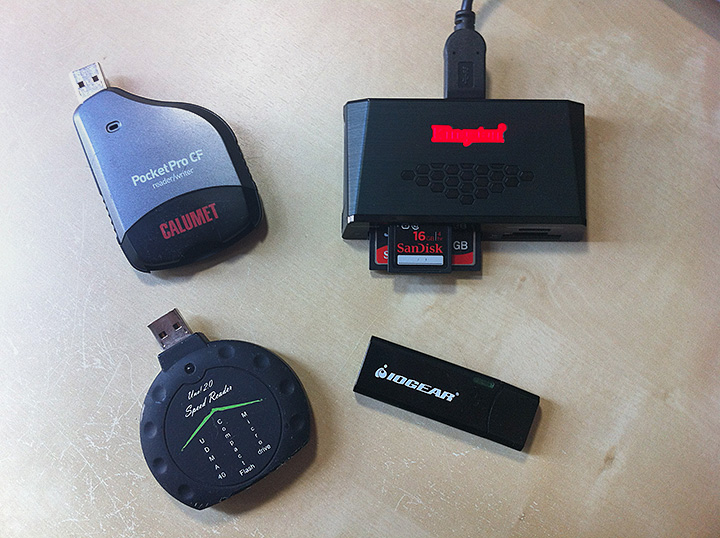One of the many things that the transition to digital photography has brought us is the ubiquitous card reader. So many types, so many choices. For example, here’s the collection that I’ve been using for a few years:

Of course you could just plug the camera into the computer with the typically included USB cable, but traditionally that has been the less popular solution. Partly because often you’re using the camera with another card while the first card is being downloaded to the computer, but mostly because the USB interfaces on cameras (at least the Canon dSLRs I’ve used) have been pretty dreadfully slow. Even though they’ve been listed as USB2 for a number of years, you’re lucky if you get 8-10MB/s out of them. This is just unacceptable when we’re talking about 16GB cards full of 500 images. Let’s face it, we don’t have all day. I’ve heard that the new Nikon D800 does USB3, but I haven’t found out if it’s any good. The growth of ethernet at the top end is also interesting, hopefully it’ll trickle down on the next revision.
And so, like many of you I’m sure, I’ve collected and shifted around from card reader to card reader over the years. My first serious reader was the Omniflash UNO! (lower left), I know it looks crappy, and it is in many ways, but for a while it was one of the only Ultra-DMA card readers available for anything approaching a reasonable price. The UDMA part means that it was reading pretty close to the maximum speed of USB2 around 30MB/s with the fastest cards. However the best part about these is that they were crazy cheap. And by cheap I mean like $6 each. So cheap that I used to buy them in multiples so I had spares when I broke them and could keep one in every bag. They were great.
However I ran out of good ones one day and didn’t have time to wait for a shipment from China, so in the meantime I went and picked up a new one at Calumet. In fact it’s their name branded PocketPro CF which I’ve been using for the past year or so and honestly it’s been trouble free. However it was over $20 and didn’t do anything the cheap ones didn’t do except last a bit long I guess.
With the purchase of my 5D Mark III and a really great sale at Best Buy one weekend, I switched from the 8GB SanDisk Extreme III CF cards I was using over to a couple 16GB SanDisk Extreme SD cards which top out at 45MB/s. Faster than USB2 can possibly go, and since I had built my nice new Hackintosh with USB3 built in I wanted to give it a go. So I picked up this cheap little IOGear USB3 SD card reader from Newegg. It looks like a USB flash drive to me, and it essentially is, only with a slot on the side that you pop a card into. It’s a little flimsy and I don’t really like the way the card sticks out of the side of it. And for some strange reason, it wouldn’t let me write to the cards from my computer saying they were read-only. In fact, every card I tried said it was read-only. None of them had the write-protect switch flipped (though I tried them in all positions including the middle which some people online suggested), but still nothing. I’ve got the reader built into the Macbook Air for travel situations so I’m not sure this thing will see much use going forward, but we’ll see.
So finally today I got delivered what I hope will be my one main reader for the foreseeable future. It’s a Kingston FCR-HS3 and as you can see in the picture above (upper right), it’s got a hole for just about everything, it’s USB3, and it just heavy enough so that I can have it towards the back edge of my desk under the monitor and it’ll stay out of the way without falling off. I did a little BlackMagic speed test and it read and wrote the SD cards at 42MB/s or better which is about what they’re rated at. Looks like this will be the best of all worlds. I think the only thing I have a problem with at the moment is that the logo has a glaringly bright LED underneath which flashes during disk operations. I’ll probably just cover over most of it with some gaffers tape. That should do the trick.
